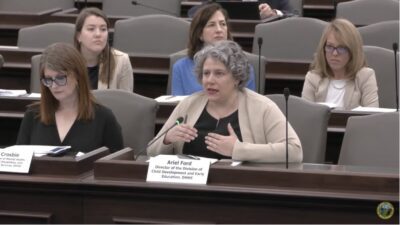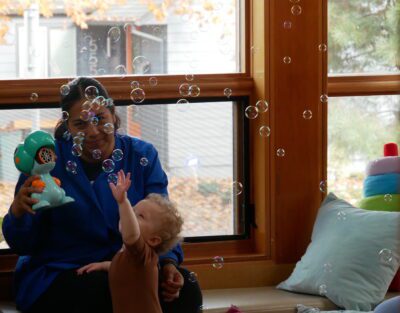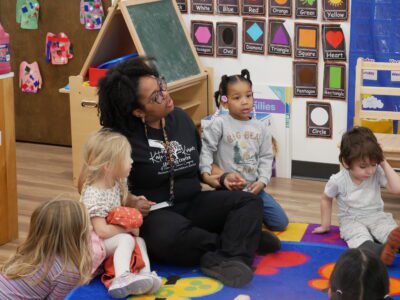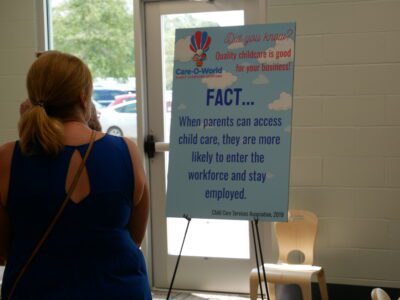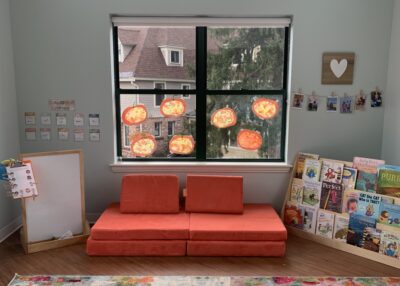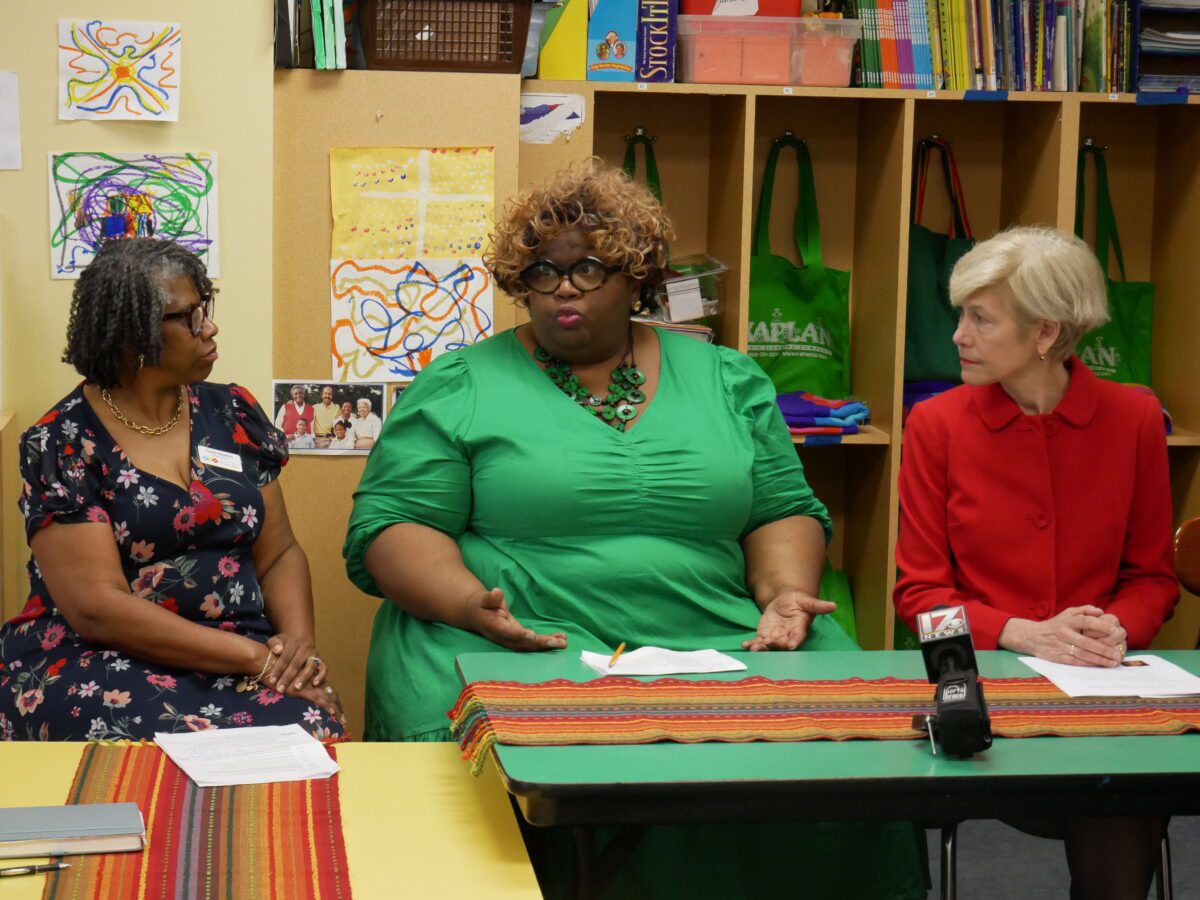
|
|
Raleigh Nursery School, like other child care programs across the state, faces excruciating choices in the coming months.
The nonprofit serving mixed-income families in downtown Raleigh will stop receiving federal stabilization funds from a pandemic-era relief initiative at the end of June.
The program will have to make up that loss somehow, Director of Operations Keisha Sanders said Thursday at a roundtable discussion with national, state, and county officials. The discussion centered on a recent $1 billion federal investment in early childhood across the country — and the need for much more.
“I’m not sure exactly what will happen if we do not get another influx of resources to our schools,” Sanders said. “We’re gonna do the best we can. We have seen hard times before. You’ll have to cut back on something.”
Those in Sanders’s position across the state are choosing between increasing already-high tuition rates, with a risk of pricing out many families, or cutting costs — mainly through reduced teacher wages. In a recent survey, almost 30% of providers who responded said they expect to close their programs altogether sometime after the funds expire.
Thursday’s event was coordinated by the office of U.S. Rep. Deborah Ross, a Democrat who represents North Carolina’s 2nd District and is running for re-election this fall.
The boost in federal funding includes $725 million in child care subsidy assistance and $275 million for Head Start, disbursed nationwide.
‘A very small drop in the bucket’
In North Carolina, the subsidy investment equates to about $24 million more in Child Care Development Block Grant (CCDBG) funds, according to a state-by-state breakdown from the Center for Law and Social Policy, a national nonpartisan nonprofit. CCDBG is the federal source of funding for states’ subsidy assistance programs, which help low-income parents afford child care.
| Distribution of 2023 discretionary funds | Estimated distribution of 2024 discretionary funds | Increase from 2023 to 2024 |
| $235,784,820 | $259,832,934 | $24,048,114 |
“One billion dollars of federal aid was just put in to child care for all over this country, which is huge, but it doesn’t nearly make the dent that it needs to make,” Ross said.
Ariel Ford, director of the Division of Child Development and Early Education (DCDEE) under the state Department of Health and Human Services, put the funding further into context.
Ford estimated that the division distributes $40 million per month in subsidy funding, which reaches only 8% to 15% of eligible families. That means the increase in funding is worth only a little more than half of one month of funding.
“The amount of funds, even though we’re so appreciative, are a very small drop in the bucket,” Ford said.
The funds have a limited reach for families, and for the providers they reimburse.
“Child care subsidy pays somewhere around, depending on the county you’re in, 30% to 50% of what it actually costs for a provider like you to operate,” Ford said, gesturing toward Sanders.
“For any business people out there, how do you run a business making a 50% loss?” Ford said. “That’s not a winning business strategy.”
More on child care challenges
That business equation leads to high prices for parents, as well as low wages for teachers. Wages have gone from an average of $12 to $14 an hour through stabilization funding, Ford estimated.
The expiration of those funds, on top of the broken subsidy system, is creating a particularly challenging moment for providers, families, and communities, she said.
“Many programs had to raise their tuition, and many more (are) saying that they’ll have to once the money runs out,” Ford said. “We know that teacher wages are likely to go down, which, as we talked about, is how we recruit and retain teachers. So we really are at an inflection point.”
‘Child care is essential’
Parents of children who attend Raleigh Nursery School shared how lucky they feel to find care they can trust, and how important it is that resources allow for high-quality and affordable care.
Anna Martin, who described her family’s economic situation as “comfortable,” said she and her spouse still struggle to afford child care — especially as costs increase for basic needs like food and housing.
After a negative experience at a different child care center, Martin said she saw firsthand how low wages and teacher turnover affect children, families, and businesses.
“Literally, we had a teacher walk out of our classroom,” Martin said. “… It just triggered a whole chain of events.”
Martin said Raleigh Nursery School, which her son has attended since February, is “a breath of fresh air.” She pointed to the school’s treatment of its teachers as a direct source of the quality care it provides.
“That being said, teachers aren’t paid enough,” Martin said. “We saw it firsthand. They deserve so much more, and the benefits to be able to live comfortably and just not be on the edge themselves.”
Tashia Fuller said her family has benefitted from both quality care and a support system from the school. Fuller works as a property coordinator at CASA NC, a nonprofit working to eliminate homelessness.
“The mental health of my children has been impacted positively because Raleigh Nursery school enables me to become more self sufficient, staying employed and providing my children with a better life after recently experiencing homelessness,” Fuller said. “Ultimately, I can show up every day to my job that is providing affordable housing to homeless families with children that were in my same situation.”
The entire community needs reliable care, Fuller said.
“Child care in this community needs additional funding and resources so that parents like me can continue to keep our jobs that are fighting other problems in our community like homelessness, educational staff shortages, mental health, social workers, that provide help with food, day care, medical care, etc.,” she said. “It goes on and on. So it’s like we’re all connected to a cause in some way. Child care is essential.”



